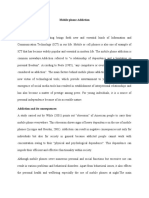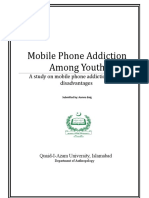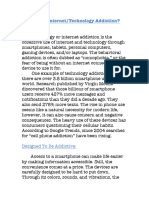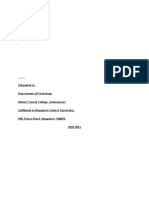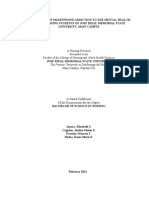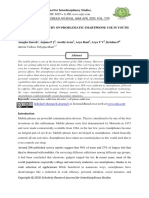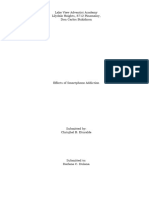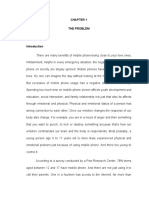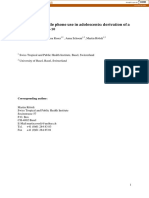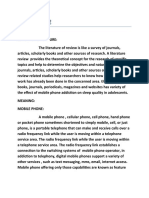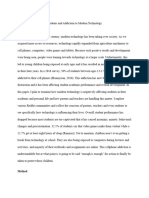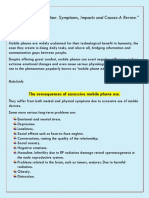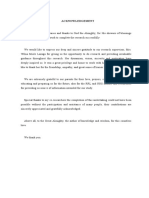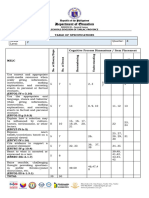Effect of Mobile Phone Addiction on Personality and Mental Health of Youth
CHAPTER – I
INTRODUCTION
Technological revolution has provided the world with luxurious inventions.
Communication channels has been so fabulously upgraded that corresponding to a persons with
thousands of miles apart is just a game of second now. Invention of fixed telephone in
19th century was no more a wonder in 21st century when human brain invented portable ―mobile
phone ―. Mobile phone technology has experience a tremendous growth. In 1946, Swedish
mobile used the first official mobile phone. In 1983, Motorola presented 1st truly portable cell
phone. According to a researcher, it took twenty years to strap up one billion mobile phone users,
forty months to harness two billion and just two years to reach the mark of 3.5 billion. This
industry has been among the fastest growing categories of consumption goods. Remarkable
growth can be seen in its users especially among young people.
Soderqvist (2008) attempted to assess use of wireless phone and health symptoms in
2000 Swedish adolescents and they showed that frequent mobile phone users reported health
complaints, such as tiredness, stress, headache, anxiety, concentration difficulties and sleep
disturbances. Regular users of wireless phones had health symptoms more often and reported
poorer perceived health than less frequent users. According to Agawam (2008), the cell phones
harmful radiations were able to degrade the quality of sperm with regard to quantity, viability,
motility, morphology and little mutation in DNA causing severe changes in sperms. Srivastava
and Tiwari (2013) investigated that the effects of excess use of cell phone on adolescent‘s mental
14
�health and quality of life. Walsh (2011) found that gender was associated with mobile phone
involvement but not frequency of use. Howell (2008) investigated gender differences related to
their mobile phones and users‘ perception and attitude towards their use in public and private
places. They concluded that while females perceived the service very positively, there was a
persistent trend for males to dislike the service, regardless of location. Technology addiction in
general and dependency on cell phones in particular are important for several reasons. Despite
the advantages and necessity of technologies for human society, due to their stimulating factors,
they results in excessive use and lead to addiction. Young people are more vulnerable to
excessive phone use, and thus, become phone dependent. Young people‘s mental health,
personality, addiction to mobile phones, as a driving force, and an active community is major
topics that are discussed in psychology and sociology. The present study addressed the question
of whether there is any relationship between the phone addiction, mental health, and personality
of youth in Hyderabad Karnataka region.
Mobile phone addiction
Mobile phone addiction can be defined as problematic functional use of the mobile phone
which has following characteristics symptoms. A strong desire to use the mobile phone ,make
phone calls or send text massages , expressed as preoccupation with those activities, the need to
increase the frequency and time of making phone calls made and text massages send. Repeated
unsuccessful efforts to cease or reduced the number of phone calls made and text messages sent,
withdrawal symptoms such as restlessness, anxiety and depression associated with attempts to
cease or reduce the number an time of phone calls and the number of text messages sent, making
longer phone calls and sending a larger number of text messages than originally intended, Lying
to family and friends to conceal the costs of and the time devoted to making phone calls and
15
�sending text massages, use of phone as a way escaping from real problems or as a mood
enhancer (to relieve loneliness, anxiety, depression or guilt). Addiction to the mobile phone is
not a homogeneous phenomenon, and therefore some researchers distinguish among addiction,
sending and receiving text massages, addiction to voice calls and addiction to mobile phone
feature and mobile phone games.
Dangers of Mobile phone addiction
Cellular phones, one of the greatest inventions in the late 20th century, now have become
the newest addiction in the world. Since the smart phone is invented, more and more people are
addicted to its entertaining system. Even through cell phone is quite important for many different
field of professions, entertainment of mobile phone is now overstep its basic needed in daily life.
Mobile entertainment system comprises a range of activates associated with mobile
electronics except its basic mobile telecommunication; data transmission and entertainment
software, such as games, social networking (e.g. twitter, face book, Skype) and Photo and Video
software, Some people even called cell phone ―the newest cigarette‖, the people are willing to
give up a week of sex than their cell phone. Of course cell phone is important to some of people
because of their job, polices; stockbrokers or doctors might have a great loss if they miss a phone
call, cell phone rise their working efficiency obviously, however, is it really important for
students that hold a cell phone all day long ? It‘s reasonable that they would like to contact their
family and friends. But if you spend 5 hours staring the screen every day, you must be addicted
to your phone.
16
� It is believed that cell phone has greater advantages than its disadvantages, and we
shouldn‘t stop to use cell phone as a popular communication tool. But when cell phone addiction
grows stronger and stronger people would eventually realize how serious it is.
Personality (more to be added here)
Everybody‘s heard the term personality, and most of us can describe our own or our
friend‘s personality; what most we don‘t know, however is that personality is one of the most
theorized and most reached aspects of psychology.
Allport defined personality as the dynamic organization within the individual of those
psychophysical systems that determine his characteristic behaviour an thought.
Addiction is a reliance on a substance or behaviour that the individual has little power to
resist.‖ Substance- based addiction are those based upon the release of dopamine in the brain,
upon which the range of sensations produced by the euphoric event in the brain changes the
brains immediate behaviour, causing more susceptibility for future addictions.
Behaviour-based addiction, on the other hand, are those that are not linked to
neurological behaviour as much and are thus thought to be linked to personality traits; it is this
type of addiction that combines behaviour with a mental state and the repeated routine is there
associated with the mental state.
Alan R.Lang, a psychology professor at Florida state university, wrote in a study that the
continuing search for the personality traits that play a part in the development of addictions are
important for the broader fight against addiction. Identifying the different personality traits will
help in the long term when it comes to the treatment of addiction, the strategies to intervene, and
17
�how to break the pattern of addiction. With addictive tragedies becoming prevalent in
communities around the United States, Scientists are asking questions about the aspects of
psychological makeup and how they contribute to addiction. They also want to know if there are
common treads that are in all addictions. Form hard drugs to cigarettes and from gambling to
overrating. Through the information that already exists on the personality‘s role in addictions,
With a lot of emphasis on drugs and alcohol , a study from the National Academy of Sciences
says that there is no single set of psychological characteristics that pertain to all addictions. The
study did show, however, that there are common elements between all addictions. As James A.
Roberts puts it, ―I get agitated when my cell phone is not in sight ―and ―I spend more time than I
should on my cell phone‖ is the mental state of the users.
Mental Health:
Mental health is an important aspect of one‘s total health status and it is a basic factor that
contributes to the maintenance of physical health and social effectiveness. It means the ability to
balance feelings, desire, ambitions and ideals is one‘s daily life. It is the ability to face and accept
the realities of life.
Mental health has two important aspects-- individual and social-. Social forces are in
constant flux. They are constantly moving and changing and therefore our mental health is
affected by various stresses. Mental health is a process of adjustment, which involves
compromise and adaptation, growth and continuity. Because of the significance of individual and
social aspects, mental health is defined as ability of the individual to make personal and social
adjustments.
18
� Mental health is the capacity of an individual to form harmonious adjustments to one‘s
social and physical environments. Menninger (1945) defined mental health as the adjustment of
human beings to the world and to each other with a maximum of effectiveness and happiness. It
is the ability to maintain an even temper, an alert intelligence, socially considerate behavior and
a happy disposition. Mental health can be described as absence of symptoms of maladjustment,
be they mild or severe. Mentally healthy person is free from all types of maladjustment (Klein,
1956). Jahoda (1958) has said that aspects of attitudes toward self, growth and development,
self-actualization, integration of personality and mastery of the environment must be considered
in judging whether a person is mentally healthy or not.
Bhatia (1982) considers mental health as the ability to balance feelings, desires,
ambitions and ideals in one‘s daily living. As part of one‘s overall health, mental and emotional
health is a necessary condition to enable one to manage one‘s life successfully. Mental health is
the emotional and spiritual resilience that allows one to enjoy life and to survive pain, suffering
and disappointment.
The National Association for Mental Health describes some of the characteristics of
people with good mental health: comfortable feelings about one‘s self, feeling of ‗right‘ about
other people and being able to meet the demands of life.
Mental health of the learner is very important for efficient learning and proper
development of personality. A child is born in a home where he remains in the constant company
of his mother in the formative years of his infancy. Traditionally, it is said the mother is equal to
hundred teachers. The impressions and experiences which a child has in these formative years
leave permanent and indelible
19
� According to the World Health Organization, ―Mental health is a state of well-being in
which the individual realizes his or her own abilities, can cope with the normal stresses of life,
can work productively and fruitfully and is able to make a contribution to his or her own
community.
A healthy individual is not only physically healthy, but is also mentally healthy. The
modern concept of health extends beyond the proper functioning of the body. It includes a sound,
efficient mind and controlled emotions. Health is a state of being, sound or whole in body and
mind‗. It means that both body and mind are working efficiently and harmoniously. Man is an
integrated psychosomatic unit, whose behaviour is determined by both physical and mental
factors.
Mental health which today is recognized as an important aspect of one‗s total health
status is a basic factor that contributes to the maintenance of physical health as well as social
effectiveness.
It is the normal state of well-being, and in the words of Johns, Sutton and Webster, is a
positive but relative quality of life. It is a condition which is characteristic of the average person
who meets the demands of life on the basis of his own capacities and limitations. By the word
relative it implied that the degree of mental health which an individual enjoys at a time is
continuously changing.
It is not mere absence of mental illness that constitutes mental health. On the other hand,
it is a positive, active quality of the individual‗s daily life. This quality of life is manifested in the
behaviour of an individual whose body and mind are working together in the same direction. His
thoughts, feelings and actions function harmoniously towards the common end. It means the
20
�ability to balance feelings, desires, ambitions and ideals in one‗s daily living. It means the ability
to face and accept the realities of life. It connotes such habits of work and attitudes towards
people and things that bring maximum satisfaction and happiness to the individual. But the
individual has to get this satisfaction and happiness without any friction with the social order or
group to which he or she belongs.
From this, one can conclude that mental health has two important aspects. It is both
individual and social. The individual aspect connotes that the individual is internally adjusted.
He is self-confident, adequate and free from internal conflicts and tensions or inconsistencies. He
is skilful enough to be able to adapt to new situations. But he achieves this internal adjustment in
a social setup. Society has certain value systems, customs and traditions by which it governs
itself and promotes the general welfare of its members. It is within this social framework that the
internal adjustment has to be built up. Only then, the individual becomes a person who is
acceptable as a member of the society.
Mental health can and should be a live experience for student. The teacher‘s part is greater in
mental health education than in physical health education because some of the mental health
problems are caused by school situations and others are aggravated by school conditions. They can
help to establish a therapeutic environment for children who have problems of living.
There are many who fail to realize the best of their potential, who find it impossible to be
happy and who suffer from minor mental and psychosomatic disturbances.
Mental health may be defined as the adjustment of the individuals to themselves and the
world at large with a maximum of effectiveness, satisfaction, cheerfulness and socially
21
�considerate behaviour and the ability of facing and accepting the realities of life, with minimum
friction and tension.
The word mental health conjures up the image of mentally ill persons in the public mind.
The WHO (1978) has stated quite clearly that mental health is not a state of absence from
diseases but a state of well being encompassing our physical, social and emotional lives. This
concept also implies that a healthy person must actualize all the potentialities of growth and
development without being unduly tense or unhappy. This concept needs some reiteration, as
overburdened medical professionals who are solely preoccupied with relief of immediate human
suffering, have dominated this field too long. It is only in recent years that a consciousness is
dawning on workers in this field, that almost every form of community activity has a direct
bearing on the state of health of its citizens. Hence, the politicians, law makers, economists,
people engaged in trade commerce, industry, educationalist‘s food and nutrition specialists,
ecology experts including doctors, nurses and social workers are all involved, either overtly or
covertly, in promoting or harming the mental health of citizens and/or in allowing them to
actualize their growth potential (Dutta Ray, 1993).
―Mental health is the balance between all aspects of life-social, physical and spiritual and
emotional‖. It impacts on how we manage our surrounding and make choice in our lives clearly
it is an integral part of overall health.
It is a state of emotional and psychological well-being in which an individual is able to
use his or he cognitive and emotional capabilities. Functioning in society and meet the ordinary
demands of everyday life.
Definitions of Mental health
22
� Agarwal, (2007) stated ―Mental health as state of well-being whereby individual‘s
recognize their abilities, or able to cope with their normal stress of life, work productivity and
fruitfully make a contribution to their communities‖.
VandenBos, (2007) defined ―Mental health is a state of mind characterized by emotional
well-being, good behavioural adjustment, relative freedom from anxiety and disabling symptoms
and a capacity to establish constructive relationships and cope with ordinary demands and
stresses of life‖.
Menninger (1945) states that mental health can be defined as the adjustment of human
being to the world and do each other with a maximum of effectiveness and happiness.
Mental Health and Well Being:
Popularly when we talk of well being, the factors of health and material conditions of the
individual and the community inevitably come to the fore (Fontana, et al., 1980; Dorothy
Haffman, 1988; and Sinha, 1990). Well being implies that the environmental provides the
necessary inputs for the proper development of those skills and abilities through which the
individual is able to satisfy his basic and psychological needs and thereby achieve a degree of
adjustment. Mental health and physical health are inexorably linked sickness and disability can
upset the delicate balance of the mind just as mental illness can affect physical health. Mental
health implies a harmonious equilibrium between the environment in which we live and our
inner selves. Man is a thinking being; inner experiences are linked to interpersonal group
experiences.
In other words, mental life is what makes peoples life valuable. Promoting health must,
therefore, be concerned not only with preserving the biological elements of the human organism,
but also with enhancing mental life. There has been a growing acceptance of the view that
23
�psychological health is not merely the absence of psychological impairment, but rather a separate
state making its own contribution to a person‘s overall well being, well being refers to how
people evaluate their lives and includes variables such as life satisfaction, lack of depression and
anxiety and positive moods and emotions. Thus, a person is said to have a high well being if he
or she experiences life satisfaction and frequent joy and only infrequently experiences unpleasant
emotions such as sadness or anger. Contrariwise, a person is said to have low well being if he or
she experiences little joy and affection and frequently feels negative emotions such as anger or
anxiety. The cognitive and affective components of well being are highly interrelated. The three
primary components of well being are: satisfaction, pleasant affect, and low levels of unpleasant
affect. All the three factors postulate that a positive self concept, a sense of autonomy, good
social support and on internal locus of control are important predictors of well being. Mental
health also includes two separate but related factors well being and personal growth (Andrews
and Withey, 1976; Campbell, 1976 and Diener, 1984).
The model of mental health designed by Taylor and Brown (1988; 1994) highlights the
fact that certain positive illusion are highly prevalent in normal though and prediction of criteria
traditionally associated with mental health. The criteria of mental health include contentment,
positive attitude towards the self, the ability to care for and about others, openness to new ideas
and people, creativity, the ability to perform creative and productive work, and the ability to
grow and develop and self actualize especially in response to stressful events.
In the light of the above background, an attempt is made in this present investigation to
assess the effect of mobile phone addiction on personality and mental health of the student
sample selected from various institutions of kalaburagi.
24
